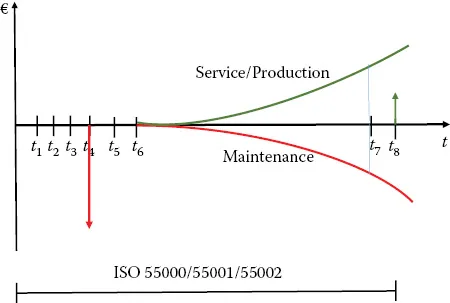1
Introduction
1.1Background
This book aims to contribute to a new vision of physical asset management and emphasizes several tools to manage the entire life cycle of physical assets. However, because this last concept is not well consolidated yet in professional language, throughout this book, I will use similar concepts, as is the case for the equipment/facilities/machines concepts and the more general concept of maintenance objects.
The objective of this book is to propose real approaches for all phases of a physical asset’s life cycle that may be summarized in the followings times and steps:
•t1—Decision about acquisition
•t2—Terms of reference
•t3—Market consultation
•t4—Acquisition
•t5—Commissioning
•t6—Starting production/maintenance
•t7—Economic/lifespan issues
•t8—Renewal/withdrawal
The next figure (Figure 1.1) shows the synthesis of all the preceding steps that will be described in this chapter as the global framework of this book.
Figure 1.1
Stages of a physical asset life cycle.
The cycle starts at time t1, with the decision about acquisition. This time has much more importance than it has traditionally been given. At this point, aspects like the following are analyzed carefully:
•The physical asset’s functions.
•The production levels expected from the asset.
•The estimated budget that may be allocated for its acquisition.
•The geographical location and conditions of asset implantation, which include aspects like the temperature, humidity, and environmental conditions.
•Others may be applicable according to the nature of the activity of the organization.
At time t1, the decision about acquisition relates directly to the planning requirement of ISO 55001, because it may attend to:
•The asset management objectives and planning to achieve them.
•The strategic asset management plan (SAMP) is the guide to setting asset management objectives.
Time t2, the terms of reference, is carefully defined. This step must be one of the most relevant for the rest of the asset life cycle. At this point, aspects like the following must be taken into consideration:
•Detailed definition of the asset’s functional specifications, namely the following:
•What are the roles of the asset?
•How long is the daily operation?
•What is the risk associated with the use of the asset?
•What is the risk associated with third parties?
•Others applicable for each specific situation.
•Detailed service and technical specifications, namely the following:
•Technical specifications
•Reliability ratios:
–Mean time between failures (MTBF)
–Mean time to repair (MTTR)
–Mean waiting time (MWT)
–Others
•Maintenance specifications
•Setting of spare parts
•Detailed definition of the documents underlying asset acquisition, like the following:
•Technical data
•Operating manual (entry into operation)
•Deployment guide
•List of components and recommended spare parts
•Assembly plan
•Detail plan
•Lubrication plan
•Line diagram
•Logical diagram
•Circuit diagram
•Pipe diagram and instruments
•Drawing of implementation
•Assembly drawing
•Report of the test program
•Certificates
•Detailed definition of the asset’s conditions of reception and installation, like the following:
•In the reception phase, it must be verified whether the delivery complies with the terms of reference specifications and the supplier’s proposal.
•All manuals should be examined and must be complete and match the version of the asset provided.
•The installation must be coordinated and supervised by a specialist or team of specialists to which the equipment belongs.
•Before the asset’s entry into operation, all licenses and required legal regulatory approvals should be obtained.
•Detailed definition of commissioning conditions:
•At this stage, it is essential to carry out a set of tests, experiments, and checks to demonstrate and prove that the asset complies with the standards and regulations specified in the terms of reference.
•Other aspects that must be considered are the following:
•Availability of new technologies
•Compliance with safety standards or other mandatory regulations
•Availability of spare parts and the number of years that they are available
•Obsolescence that can limit the asset’s competitive use
•Guarantees...

